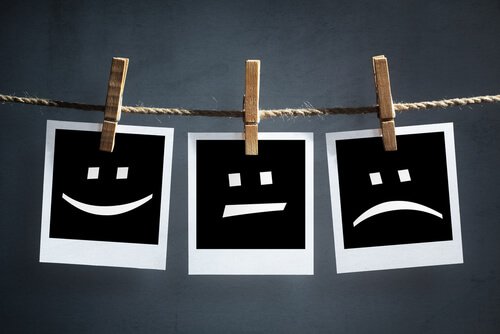Do You Know the Functions of Emotions?

Johnmarshall Reeve is an author who, in recent decades, has contributed to studies about motivation and emotions. Reeve believes that there are three main functions of emotions: adaptive, social, and motivational. Let’s take a look at each one of them, what they consist of and how, on occasion, inhibiting an emotional reaction can also be useful.
Pride, fear, joy, anger, or shame are emotions that produce a triple effect on people. On the one hand, they cause subjective consequences, which we often express in the form of feelings or emotional states. On the other hand, there are also physiological effects. These refer to changes that experiencing these emotions cause in our cells, tissues, organs, and body in general. Finally, these emotions can also motivate behavior.
Adaptive function
One of the most important functions of emotions is preparing the body for action. In this sense, each emotion, regardless of any positive or negative connotations, is useful in its own way.

Thanks to the adaptive functions of emotions, we can effectively jump into action when needed. These emotions allow us to mobilize and have enough of the necessary energy to complete a task or flee when needed. For example, when we see someone nearby crying, we have a natural emotional response that makes us approach the person and take interest in why they’re upset.
Charles Darwin himself pointed out the relevance of emotions as an adaptive mechanism. Darwin considered emotions as facilitators of appropriate behavior. To examine the adaptive functions of emotions more closely, here are the functions of each primary emotion (P. Ekman):
| Primary Emotion | Adaptive Function (use) |
| Happiness | Feeling of closeness to others |
| Disgust | Rejection |
| Anger | Self-defense |
| Fear | Protection |
| Surprise | Exploration |
| Sadness | Reintegration |
Social function
“I’m embarrassed.” “I feel overjoyed.” “This makes me nervous.” All of these phrases refer to emotional states. Emotions communicate our emotional state of mind and express what is going on inside. In addition, they also facilitate social interaction. Emotions help the people around us predict our behavior and allow us to try to predict theirs. Due to this, emotions are very useful and necessary in interpersonal relationships.
Sometimes we struggle to define emotions verbally. It’s important to keep in mind that we don’t only express emotions orally. There are other ways to observe how someone is feeling besides asking them, since it may be difficult for the person to express exactly how they’re feeling. By observing body posture or facial expressions, we can sometimes see more clearly how someone is feeling than by asking them. Often, a certain posture or expression is more informative than “I’m sad”.
“Almost everyone thinks they know what an emotion is until they try to define it. At that time, practically nobody is able to express it with words.”
-Wegner, Jones & Jones-

However, even not communicating emotions or preventing ourselves from expressing certain emotions can occasionally play a social function. This is particularly true in cases where hiding an emotion or not showing how we really feel helps to keep a friendship alive. In these cases, “the cure is worse than the disease”. Sometimes, it’s better to withhold how we really feel so we don’t hurt or upset the other person.
Generally, emotion inhibition causes misunderstandings and a significant physiological burden. In addition to being entirely avoidable, this can also be very harmful. On the other hand, expressing emotions and showing our feelings in a healthy and controlled way is beneficial. Expressing our emotions also helps strengthen our social support network.
Social contagion
The concept of social contagion may be one of the reasons why we’re more attracted to positive people than to negative ones. Social contagion refers to the idea that emotions can be spread from person to person. Humans are genetically predisposed to social contagion. We let ourselves get carried away by the emotions of others. However, there are people who are more able to both transmit and capture others’ emotions.
Motivational function
Emotions also have a motivational function. The relationship between motivation and emotions is bidirectional. There is constant feedback between emotions and motivation and vice versa.
On the one hand, all motivative behavior produces an emotional reaction. On the other hand, emotions fuel motivation. Motivation often influences how to we display our emotions, to what intensity, and how we let them guide our behavior in our direction or another.
For example, if we feel happy and enjoy having a cup of coffee with someone, we’ll feel more motivated to spend time with that person again. On the contrary, a bad experience with someone will cause a negative emotional reaction that will make us think twice before agreeing to see that person again.
Emotions are the primary system for motivating human behavior. They essentially are the catalyst for creating motivated behavior. This is also true for the processes of perception, reasoning, and motivating action.

Now we know about the main functions of emotions. Once you’re aware of them, it’s easier to be more aware of the physiological changes we experience throughout the day. How many emotions do you have in the course of 24 hours? Just imagine the number of changes that occur in our bodies daily as a result of our emotions!
All cited sources were thoroughly reviewed by our team to ensure their quality, reliability, currency, and validity. The bibliography of this article was considered reliable and of academic or scientific accuracy.
- Keltner, D., & Haidt, J. (1999). Social functions of emotions at four levels of analysis. Cognition and Emotion. https://doi.org/10.1080/026999399379168
- Izard, C. E. (2011). Forms and functions of emotions: Matters of emotion-cognition interactions. Emotion Review. https://doi.org/10.1177/1754073911410737
This text is provided for informational purposes only and does not replace consultation with a professional. If in doubt, consult your specialist.








